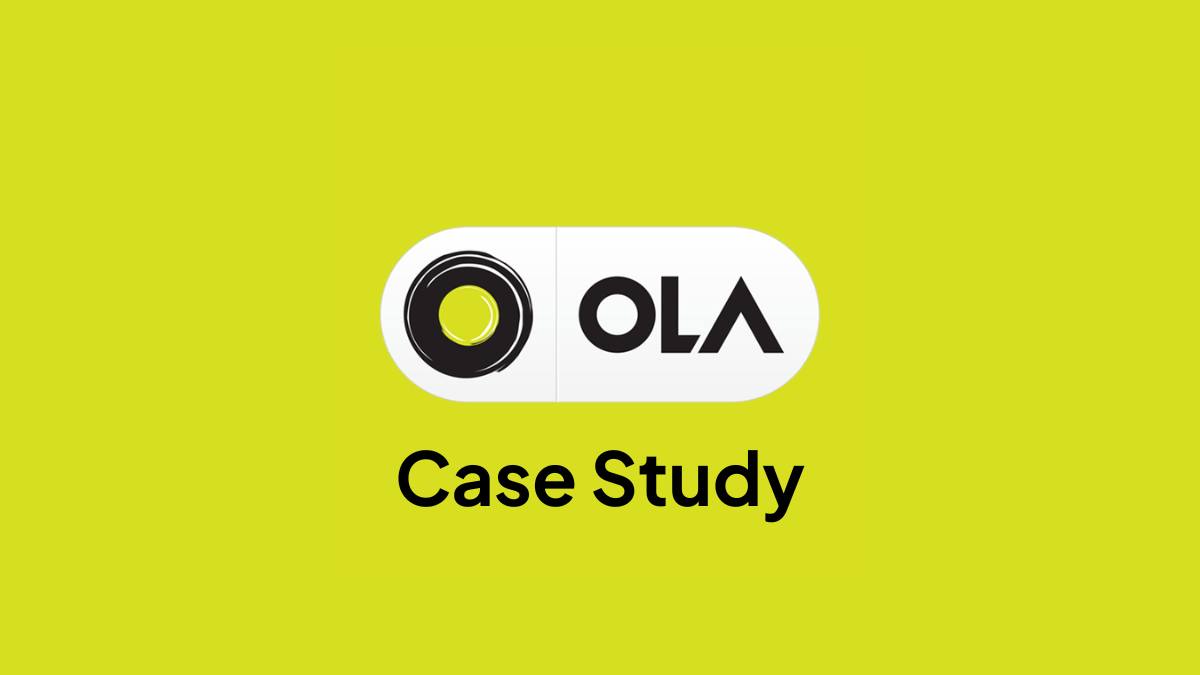You know how, in India, getting from point A to B used to be a mini-adventure? You’d have to haggle with auto-walas, wait forever for a cab, and half the time, you’d end up paying more than you should. It wasn’t exactly smooth.
That’s the world Ola entered back in 2010.
What started as a pretty basic car rental idea ended up becoming one of the most impactful mobility companies in India. It didn’t just give people rides, it changed how Indians think about transport.
So why should you care about Ola’s journey?
Because it’s packed with lessons. Real ones. About how to spot a real-world problem. About adapting to local behavior. About building trust in a market where trust is kind of hard to earn.
And if you’re into marketing, startups, product thinking, or growth strategy, this Ola Case Study is gold.
The Beginning: How Ola Got Rolling
So here’s how it all started. Bhavish Aggarwal (yep, an IIT grad, because of course) was running a small site that rented out holiday packages. On one of his own trips, he had a pretty crappy experience trying to book a cab. It was expensive, slow, and just overall not great.
That frustrating moment turned into a business idea.
He and his co-founder, Ankit Bhati, decided to start Ola Cabs, but in the beginning, it wasn’t about daily rides. It was just car rentals. Think: outstation trips and chauffeur-driven vehicles.
But then came the big pivot.
They realized that what Indians really needed wasn’t rentals… it was quick, on-demand rides in cities. You press a button, and a cab comes to you. Like magic, but functional.
This shift, from rentals to ride-hailing, changed everything.
And the timing was perfect. Smartphones were becoming affordable. Mobile internet was picking up. People were finally comfortable downloading apps.
Ola rode that wave.
They started small in cities like Mumbai and Bangalore. Onboarded a bunch of drivers. Launched an app. And started offering a much smoother way to book rides compared to… whatever we had before.
Before long, they were India’s go-to ride app.
Also Read: Zara Case Study
Real India = Real Challenges
Now, let’s be honest, India isn’t the easiest market to build something like Ola. The problems weren’t just technical. They were cultural, behavioral, infrastructural.
Here are some of the big ones Ola ran into:
1. Messy Pricing
Before Ola, there was no such thing as “standard fare.” Drivers could say ₹250 or ₹450 for the same distance, and you had no clue what was fair. Ola had to somehow introduce pricing that made sense for both riders and drivers.
2. Where Are The Drivers?
You’d open the app and… nothing nearby. Or sometimes, too many cabs in one spot. Figuring out where to place supply to match demand wasn’t easy, especially in cities where traffic patterns change every hour.
3. A Totally Unorganized Taxi Market
Most cab drivers weren’t part of any system. No tech. No formal structure. Ola had to convince them to use smartphones, follow GPS, and trust an algorithm to give them income. Not a small ask.
4. Riders Didn’t Feel Safe
This was a huge one. Getting into a car with a stranger, especially late at night, felt risky. Ola needed to create a sense of safety, and not just talk about it. Actually bake it into the experience.
5. Digital Payments Weren’t a Thing Yet
Back then, not many people used online wallets or UPI. Ola had to make sure you could still pay with cash while slowly nudging people toward digital options.
Long story short, Ola wasn’t building in Silicon Valley. They were building in India, for India. Which meant they had to solve real, gritty, day-to-day problems.
Also Read: Netflix Case Study
How Ola Actually Solved It All
Okay, so how did they pull it off?
Not with one big masterplan, but a bunch of smart, India-first decisions.
1. The App Was Simple, Fast, and Local
Ola’s app wasn’t fancy, it just worked. Booking a ride took maybe two taps. And it supported multiple Indian languages. That made it friendly even for folks who weren’t tech-savvy.
2. Driver Onboarding = Growth Engine
They made it easy for drivers to join. Ola helped them get smartphones, gave them basic training, and even offered earnings guarantees to reduce risk.
It was like, “You drive, we’ll make sure you earn.”
3. Dynamic Pricing (Surge, Basically)
If demand spiked, prices adjusted. That meant drivers had a reason to go online during busy hours. It was a win-win: more availability for users, better income for drivers.
4. Ola Knew India Is Not One India
They didn’t assume everyone’s needs were the same. In big cities, people booked Prime Sedans. In smaller towns, Ola Auto and Ola Bike made more sense. They also added cash payments and wallet options because… yeah, not everyone had credit cards.
5. Safety Was Built-In
They didn’t just talk about safety, they made it part of the experience:
- OTP before the trip starts
- SOS button in the app
- Share-your-ride features
- Driver background checks
These tools helped ease a lot of the anxiety around ride-hailing.
6. They Kept Adding New Services
Instead of just doing cabs, they kept branching out:
- Ola Auto for short rides
- Ola Bike for budget travel
- Ola Money to simplify payments
- Ola Electric to bet on the future of mobility
That way, they weren’t stuck in one lane. They were building a full mobility ecosystem.
💡 Want to learn how brands like Ola solve real-world problems with smart marketing and growth strategies?

Explore these concepts inside our Digital Marketing Course – packed with case studies, actionable frameworks, and hands-on projects.
Ola’s Business Model Explained
Now, let’s talk about how Ola makes money, because that’s always the big question, right?
At its core, Ola runs what’s called an asset-light platform model. That means they don’t own the vehicles. Instead, they connect riders (you and me) with drivers (who bring their own cars or lease them).
Here’s where the money comes from:
1. Ride Commissions
This is the big one. Every time you book a ride, Ola takes a cut from what the driver earns. The percentage varies depending on the city, demand, and incentives, but it’s the primary revenue stream.
2. Subscriptions & Passes
They experimented with things like Ola Select, which gave you priority bookings, no peak pricing, and more. Some users paid a monthly fee for these perks.
3. Vehicle Leasing
Ola used to run a leasing program where drivers could lease a car through Ola and pay it off over time. It helped people who didn’t own a vehicle to start earning quickly.
4. Ola Money
This is their digital wallet. It makes payment smoother for users, and Ola earns a small cut on certain transactions. They even tried adding insurance and micro-loans here.
So yeah, Ola doesn’t make all its money from rides alone. They’ve built a full ecosystem around transport and payments.
But here’s the thing: Even with all this, profitability has been tricky. Like many startups, Ola focused more on growth and market share in the beginning, which meant burning cash on discounts, incentives, and expansion.
Also Read: Uniqlo Case Study
Ola’s Marketing & Growth Strategy
Ola didn’t become a household name just because it had a good app. It marketed smartly, with a deep understanding of what Indian users respond to.
1. Localized Campaigns
Remember the “Chalo Niklo” campaign? It wasn’t just catchy, it tapped into everyday Indian life. They created city-specific promos too. Offers during festivals. Free rides on elections. Discounts when pollution spiked (with Ola Bike rides).
It wasn’t just ads. It was contextual marketing.
2. Referral Programs
This was huge. Early on, Ola pushed user referrals hard. You’d get ₹100 if your friend joined. Drivers also got bonuses for bringing in other drivers.
It created a loop. More users meant more drivers, which meant better availability.
3. Retargeting & Engagement
Ola was always nudging you back. If you didn’t open the app for a while, you’d get a push notification with a discount. If you booked a cab at 9 AM every day, they’d remind you around that time.
It wasn’t random. It was data-driven, but not creepy.
4. Location-Based Offers
Depending on where you were, Ola would surface different ride options or offers. Near a metro? You’d see a ride combo. At an airport? You’d see Prime or rentals.
5. Performance Marketing + Influencers
Ola also ran ads across Google, Facebook, and Instagram. Plus, they worked with local influencers and creators to push content that felt authentic, not polished brand fluff.
All this gave them serious reach. But more importantly, it made Ola feel relevant to different kinds of people in different places.
Also Read: Amul Case Study
Expansion & Diversification Strategy
Ola didn’t just stop at cabs in big cities. They had their sights on much more.
1. Going Beyond Tier-1
They expanded to Tier-2 and Tier-3 towns early on, places where Uber was slower to enter. Ola tweaked its strategy for these markets by:
- Offering more autos and bikes (cheaper)
- Supporting cash payments more heavily
- Running local driver onboarding camps
Smart move. It got them deeper penetration and built early loyalty.
2. International Forays
Ola also went global, to Australia, New Zealand, and even the UK. It wasn’t a complete win, but it showed ambition.
3. New Products & Businesses
Apart from Ola Cabs, they launched:
- Ola Electric (for two-wheelers, cars, and batteries)
- Ola Dash (quick grocery delivery, though this didn’t last)
- Ola Cars (used car platform, also scaled back later)
They also bought Foodpanda India, tried food delivery for a bit, then pivoted away (Source). Bought Ridlr to improve public transport integration. And picked up TaxiForSure to kill competition.
Not every bet paid off, but that’s the nature of the game when you’re building big.
Also Read: Dunkin’ Donuts Case Study
Roadblocks & Recent Challenges
Now, let’s not pretend it’s all rosy. Ola has had its fair share of issues, some internal, some external.
1. Driver Protests
A lot of drivers felt squeezed over time. Ola reduced incentives as it matured, which hurt earnings. There were strikes. Some drivers left for competitors. The balance between keeping users happy and drivers happy? Not easy.
2. Regulatory Trouble
Different cities had different rules. Some banned bike taxis. Others objected to Ola’s pricing model. Karnataka, for instance, temporarily banned Ola at one point.
So yeah, navigating local laws is a constant fight.
3. Ola Electric Hiccups
Big dreams here, but delivery has been bumpy. There have been complaints about quality issues, missed timelines, and unclear communication around launches.
Still early days, but expectations are high.
4. Profitability vs. Growth
This is the classic startup tension. Ola is still trying to find the right balance. Cut burn, grow sensibly, and eventually make profits. But it’s not simple when your model depends on scale and thin margins.
Also Read: Starbucks Case Study
Key Takeaways & Marketing Lessons
Let’s pause and look at what we can learn from all this, whether you’re a marketer, founder, or just someone trying to build something meaningful.
1. Solve a Real Pain Point
Ola didn’t invent something flashy. It solved a daily problem in a broken system, and that’s why it worked.
2. Be Hyperlocal
They didn’t copy-paste a Western model. They built for India, in India, with Indian users in mind.
3. Use Tech to Scale, But Stay Human
Their algorithms were smart, but their growth came from how they used tech, to improve trust, ease, and earnings.
4. Trust is a Feature
Safety tools, reliable fares, consistent support, they didn’t just help riders feel safe. They built loyalty.
5. Don’t Be Afraid to Expand (But Know When to Cut)
Ola tried many things. Some stuck. Some didn’t. That’s okay, as long as you learn fast and focus on what works.
6. Start Simple. Then Optimise Like Crazy
The first version of Ola wasn’t perfect. But they kept improving, based on data and feedback. That’s how they stayed ahead.
Also Read: Dollar Shave Club Case Study
Conclusion
Ola’s story isn’t just about an app that helps you book a cab. It’s about spotting a broken system, listening to what real people need, and building something that actually works in their world. By leaning into India’s complexities, language, cash habits, local routes, they didn’t just create a ride-hailing service, they reshaped daily commute for millions.
It’s also a solid reminder that timing matters. Ola showed up when smartphones were getting cheaper, data was going mainstream, and people were slowly getting used to digital payments. But tech alone wouldn’t have done it. It was their local understanding, plus fast, smart execution, that made the difference.
For marketers, founders, or product folks, Ola’s journey is a crash course in how to grow quickly without losing relevance. It’s about staying agile, obsessing over your users, and never losing sight of the real problem you’re solving.
FAQs: Ola Case Study
Q1. What is Ola’s primary revenue source?
Ola earns mainly from commissions on each ride booked through the app. They also make money from Ola Money transactions and through driver vehicle leasing programs.
Q2. What is Ola’s business model?
Ola runs a platform model connecting riders and drivers. It earns through commissions, payments, and services without owning vehicles. It blends B2C for customers and B2B with driver-partners.
Q3. Is Ola profitable in India?
Not consistently. Ola has reported losses due to deep discounts and expansion costs. But it’s betting on electric mobility and cost control for future profitability.
Q4. Who are Ola’s biggest competitors?
In India, Ola’s top rivals include Uber, Rapido for bike taxis, and various local auto and cab aggregator apps in smaller cities.
Q5. What is Ola’s marketing strategy in India?
Ola focuses on localized, city-specific campaigns, app-based offers, referral programs, and digital ads. They also use influencer content and push notifications smartly.
Q6. Why was Ola banned in some cities?
In some regions, Ola faced bans due to pricing issues, permit conflicts, or running bike taxis without regulatory approval. Local rules vary, and friction happens.

